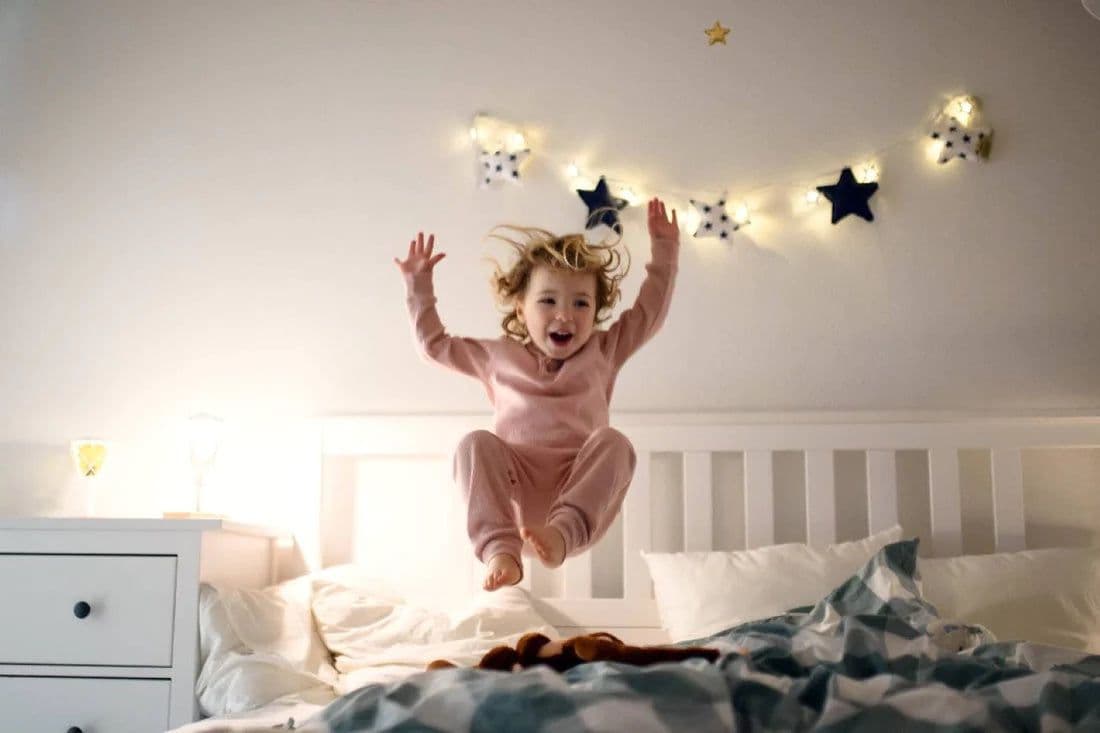TODDLER
8 Bedtime Routine Saboteurs! (& How to Fight Them)
Learn the most common bedtime routine mistakes—and how to fix them.

Written by
Happiest Baby Staff

SHARE THIS ARTICLE
PARENT PICKS
Bestsellers
TODDLER

Written by
Happiest Baby Staff

SHARE THIS ARTICLE
Bestsellers
By now you likely know that babies, toddlers, and big kids thrive on routine—and bedtime routines are no different. But sometimes the habits or behaviors we’ve baked into our child’s bedtime routine actually work against our ultimate goal of sleep. If you’re dealing with bedtime struggles, middle-of-the-night wakeups, or otherwise not-great kid-sleep, it may be time to rethink your child’s bedtime routine. Keep reading to learn if you’ve fallen prey to some of the most common bedtime routine mistakes parents inadvertently making…and how to fix them.
A routine is not a routine if there’s no consistency! So, if your child’s bedtime continually fluctuates, if you’re regularly skipping bath or stories to fast-forward tuck-in, or if you take turns with your partner putting you bub to bed, but neglect to sync up your strategies, there’s is no “routine” in your child’s bedtime routine. The result: Your little one is left confused about what to expect every night, which hampers comfort and sleep.
The solution, of course, is to set up a clear and consistent bedtime routine that features a predictable sequence of events every night. Doing so builds trust and comfort—and brings the ZZZs. In fact, parents of 7- to 36-month-olds who adopted a predictable and calming three-step bedtime routine that included a nightly bath, massage, and quiet cuddling or singing saw their children fall asleep faster, sleep longer—and they were less likely to call out to their parents than when the routine wasn’t in place.
A child’s bedroom that appears comfy, cozy, and perfect for sleep might actually harbor a big sleep saboteurs: light. When light peaks into your child’s sleep space, it can keep their brain on alert and disrupt their natural circadian rhythm, which relies on light and dark cues to help them sleep and wake up. To figure out if your little one’s room is secretly working against their need for ZZZs, lay in your child’s bed one night with the lights off and look around. Is light from a streetlamp sneaking in? What about from under the door? Is there an abandoned iPad on the dresser? How bright or dim is their nightlight? Afterward, figure out if you need to make the following tweaks:
It’s important to engage in only calming, quiet play and activities before lights out. That means no roughhousing or playing with light-up or noisy toys before bed! Make sure your bedtime stories are lighthearted and reassuring, too. Some spot-on activities to consider adding into your child’s bedtime routine include:
Since white noise (aka Shushing) is an integral part of the 5 S’s for soothing babies, parents might think white noise is only important for baby sleep…but that’s untrue! White noise can help everyone get the rest they need. Once you start using white noise in the background during your little one’s bedtime routine, they’ll start to expect it and make the connection that white noise means sleepytime is here. White noise also creates a “blanket of sound” that masks sudden shifts in sound consistency, like a dog barking or a noisy truck passing by, that can wake up kids (and grownups). Finally, white noise even helps to distract children from some common internal sleep-sappers, like teething pain or a slightly stuffy nose. Essentially, white noise gives your tot something else to pay attention to, which can then help lull them to sleep. (SNOObear and SNOObie both offer the very same paediatrician-designed white noise as the award-winning SNOO.)
No matter if you’re a child chilling to an episode of Paw Patrol or a grownup scrolling Instagram, electronics stimulate the brain, delay/hinder REM sleep, and hamper the release of the sleepytime hormone, melatonin. And because children’s eyes are not yet fully developed, researchers believe that they’re even more sensitive to the impact of light on the internal body clock than adults. That’s why the American Academy of Pediatrics recommends absolutely no screens 60 minutes before bedtime—and limiting all screentime to an hour or less for tots between 2 and 5 years old. Still, other experts encourage capping screens 90 minutes prior to bedtime, noting that before bed screen time has a “strong, negative effect on sleep quantity and quality.”
Research shows that only about 10% of families offer their children a lovey as a sleepytime companion. Paediatrician Dr. Harvey Karp speculates that parents may resist loveys because they worry their little one will become dependent. “Parents who turn their backs on loveys are missing a huge opportunity!” says Dr. Karp. “These cuddly friends are a wonderful sleep aid, they help babies and toddlers build confidence and security, and they work wonders for easing separation anxiety.” They’re especially comforting amid times of stress, like during travel, as well. (Even the AAP notes that loveys help children make the emotional transition from dependence to independence.) Here’s how to make a lovey part of your tot’s bedtime routine:
Did you know that there’s an ideal temperature for sleep? And if your child’s room is warmer or cooler than that temperature, their sleep can very easily run amuck? It’s true! When you’re turning on your bub’s white noise machine and settling in for storytime, take a gander at the thermostat, ensuring that it’s between 68 to 72 degrees Fahrenheit, which is the sweet spot for slumber, notes Dr. Karp. At the same time, dress your child in pyjamas, bodysuits, or sleep sacks made of breathable cotton—not sweaty synthetics, like fleece, that can cause overheating. If you’re able, consider organic cotton, which is considered more breathable than regular cotton.
Bedtime can be frustrating for parents, for sure. But if you let that frustration come out as you’re leaving your child’s room, disaster can ensue! To help ensure a sweet good-bye, try what Dr. Karp calls bedtime sweet talk. “Right before your little one drifts off to sleep, their mind is wide open and ready for your loving words,” says Dr. Karp. “So, take the opportunity to fill your tyke’s sleepy mind with gratitude for all the wonderful things they did that day. This will nurture their sense of optimism about all the things they may do and experience tomorrow.” Here’s how to do it, according to Dr. Karp, bestselling author of The Happiest Toddler on the Block:
Toddler bedtime sweet talk makes bedtime something your child looks forward to...instead of something to avoid! Plus, it’s a huge confidence boost that helps your child drift off with a full heart and wake up the next morning ready for anything! Finally, bedtime sweet talk is a wonderful way to build bonding into your child's bedtime routine, to boot!
***
REFERENCES
Disclaimer: The information on our site is NOT medical advice for any specific person or condition. It is only meant as general information. If you have any medical questions and concerns about your child or yourself, please contact your health provider. Breastmilk is the best source of nutrition for babies. It is important that, in preparation for and during breastfeeding, mothers eat a healthy, balanced diet. Combined breast- and bottle-feeding in the first weeks of life may reduce the supply of a mother's breastmilk and reversing the decision not to breastfeed is difficult. If you do decide to use infant formula, you should follow instructions carefully.